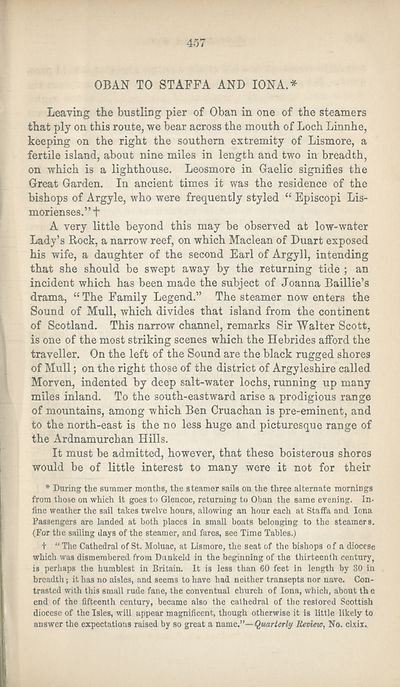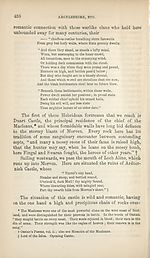Download files
Complete book:
Individual page:
Thumbnail gallery: Grid view | List view

457
OBAN TO STAPFA AND IONA.*
Leaving the bustling pier of Oban in one of the steamers
that ply on this route, we bear across the mouth of Loch Linnhe,
keeping on the right the southern extremity of Lismore, a
fertile island, about nine miles in length and two in breadth,
on which is a lighthouse. Leosmore in Gaelic signifies the
Great Garden. In ancient times it was the residence of the
bishops of Argyle, who were frequently styled “ Episcopi Lis-
morienses.” +
A very little beyond this may be observed at low-water
Lady’s Rock, a narrow reef, on which Maclean of Duart exposed
his wife, a daughter of the second Earl of Argyll, intending
that she should be swept away by the returning tide ; an
incident which has been made the subject of Joanna Baillie’s
drama, “ The Family Legend.” The steamer now enters the
Sound of Mull, which divides that island from the continent
of Scotland. This narrow channel, remarks Sir Walter Scott,
is one of the most striking scenes which the Hebrides afford the
traveller. On the left of the Sound are the black rugged shores
of Mull; on the right those of the district of Argyleshire called
Morven, indented by deep salt-water lochs, running up many
miles inland. To the south-eastward arise a prodigious range
of mountains, among which Ben Cruachan is pre-eminent, and
to the north-east is the no less huge and picturesque range of
the Ardnamurchan Hills.
It must be admitted, however, that these boisterous shores
would be of little interest to many were it not for their
* During the summer months, the steamer sails on the three alternate mornings
from those on which it goes to Glencoe, returning to Oban the same evening. In-
fine weather the sail takes twelve hours, allowing an hour each at Staffa and Iona
Passengers are landed at both places in small boats belonging to the steamers.
(For the sailing days of the steamer, and fares, see Time Tables.)
t “The Cathedral of St. Moluac, at Lismore, the seat of the bishops of a diocese
which was dismembered from Dtinkeld in the beginning of the thirteenth century,
is perhaps the humblest in Britain. It is less than 60 feet in length by 30 in
breadth; it has no aisles, and seems to have had neither transepts nor nave. Con¬
trasted with this small rude fane, the conventual church of Iona, which, about th e
end of the fifteenth century, became also the cathedral of the restored Scottish
diocese of the Isles, will appear magnificent, though otherwise it is little likely to
answer the expectations raised by so great a name.”—Qmrterly Review, No. clxir.
OBAN TO STAPFA AND IONA.*
Leaving the bustling pier of Oban in one of the steamers
that ply on this route, we bear across the mouth of Loch Linnhe,
keeping on the right the southern extremity of Lismore, a
fertile island, about nine miles in length and two in breadth,
on which is a lighthouse. Leosmore in Gaelic signifies the
Great Garden. In ancient times it was the residence of the
bishops of Argyle, who were frequently styled “ Episcopi Lis-
morienses.” +
A very little beyond this may be observed at low-water
Lady’s Rock, a narrow reef, on which Maclean of Duart exposed
his wife, a daughter of the second Earl of Argyll, intending
that she should be swept away by the returning tide ; an
incident which has been made the subject of Joanna Baillie’s
drama, “ The Family Legend.” The steamer now enters the
Sound of Mull, which divides that island from the continent
of Scotland. This narrow channel, remarks Sir Walter Scott,
is one of the most striking scenes which the Hebrides afford the
traveller. On the left of the Sound are the black rugged shores
of Mull; on the right those of the district of Argyleshire called
Morven, indented by deep salt-water lochs, running up many
miles inland. To the south-eastward arise a prodigious range
of mountains, among which Ben Cruachan is pre-eminent, and
to the north-east is the no less huge and picturesque range of
the Ardnamurchan Hills.
It must be admitted, however, that these boisterous shores
would be of little interest to many were it not for their
* During the summer months, the steamer sails on the three alternate mornings
from those on which it goes to Glencoe, returning to Oban the same evening. In-
fine weather the sail takes twelve hours, allowing an hour each at Staffa and Iona
Passengers are landed at both places in small boats belonging to the steamers.
(For the sailing days of the steamer, and fares, see Time Tables.)
t “The Cathedral of St. Moluac, at Lismore, the seat of the bishops of a diocese
which was dismembered from Dtinkeld in the beginning of the thirteenth century,
is perhaps the humblest in Britain. It is less than 60 feet in length by 30 in
breadth; it has no aisles, and seems to have had neither transepts nor nave. Con¬
trasted with this small rude fane, the conventual church of Iona, which, about th e
end of the fifteenth century, became also the cathedral of the restored Scottish
diocese of the Isles, will appear magnificent, though otherwise it is little likely to
answer the expectations raised by so great a name.”—Qmrterly Review, No. clxir.
Set display mode to:
![]() Universal Viewer |
Universal Viewer | ![]() Mirador |
Large image | Transcription
Mirador |
Large image | Transcription
| Antiquarian books of Scotland > Scotland/Scots > Black's picturesque tourist of Scotland > (577) |
|---|
| Permanent URL | https://digital.nls.uk/130035114 |
|---|
| Description | Thousands of printed books from the Antiquarian Books of Scotland collection which dates from 1641 to the 1980s. The collection consists of 14,800 books which were published in Scotland or have a Scottish connection, e.g. through the author, printer or owner. Subjects covered include sport, education, diseases, adventure, occupations, Jacobites, politics and religion. Among the 29 languages represented are English, Gaelic, Italian, French, Russian and Swedish. |
|---|

